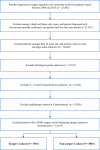Nomograms to estimate long-term overall survival and tongue cancer-specific survival of patients with tongue squamous cell carcinoma
- PMID: 28411370
- PMCID: PMC5430099
- DOI: 10.1002/cam4.1021
Nomograms to estimate long-term overall survival and tongue cancer-specific survival of patients with tongue squamous cell carcinoma
Abstract
The aim of this study was to construct nomograms to predict long-term overall survival (OS) and tongue cancer-specific survival (TCSS) of tongue squamous cell carcinoma (TSCC) patients based on clinical and tumor characteristics. Clinical, tumor, and treatment characteristics of 12,674 patients diagnosed with TSCC between 2004 and 2013 were collected from the Surveillance, Epidemiology, and End Results database. These patients were then divided into surgery and nonsurgery cohorts, and nomograms were developed for each of these groups. The step-down method and cumulative incidence function were used for model selection to determine the significant prognostic factors associated with OS and TCSS. These prognostic variables were incorporated into nomograms. An external cohort was used to validate the surgery nomograms. Seven variables were used to create the surgery nomograms for OS and TCSS, which had c-indexes of 0.709 and 0.728, respectively; for the external validation cohort, the c-indexes were 0.691 and 0.711, respectively. Nine variables were used to create the nonsurgery nomograms for OS and TCSS, which had c-indexes of 0.750 and 0.754, respectively. The calibration curves of the 5- and 8-year surgery and nonsurgery nomograms showed excellent agreement between the probabilities and observed values. By incorporating clinicopathological and host characteristics in patients, we are the first to establish nomograms that accurately predict prognosis for individual patients with TSCC. These nomograms ought to provide more personalized and reliable prognostic information, and improve clinical decision-making for TSCC patients.
Keywords: Head and neck; nomogram; overall survival; tongue cancer-specific survival; tongue squamous cell carcinoma.
© 2017 The Authors. Cancer Medicine published by John Wiley & Sons Ltd.
Figures




Similar articles
-
Nomograms to predict survival of stage IV tongue squamous cell carcinoma after surgery.Medicine (Baltimore). 2019 Jun;98(26):e16206. doi: 10.1097/MD.0000000000016206. Medicine (Baltimore). 2019. PMID: 31261568 Free PMC article.
-
A novel nomogram for predicting overall survival in patients with tongue squamous cell carcinoma using clinical features and MRI radiomics data: a pilot study.World J Surg Oncol. 2024 Aug 29;22(1):227. doi: 10.1186/s12957-024-03508-0. World J Surg Oncol. 2024. PMID: 39198807 Free PMC article.
-
[Establishment and verification of a prognostic nomogram for survival of tongue squamous cell carcinoma patients who underwent cervical dissection].Beijing Da Xue Xue Bao Yi Xue Ban. 2024 Feb 18;56(1):120-130. doi: 10.19723/j.issn.1671-167X.2024.01.019. Beijing Da Xue Xue Bao Yi Xue Ban. 2024. PMID: 38318906 Free PMC article. Chinese.
-
Nomograms forecasting long-term overall and cancer-specific survival of patients with oral squamous cell carcinoma.Cancer Med. 2018 Apr;7(4):943-952. doi: 10.1002/cam4.1216. Epub 2018 Mar 7. Cancer Med. 2018. PMID: 29512294 Free PMC article.
-
Development and validation of novel nomograms to predict survival of patients with tongue squamous cell carcinoma.World J Clin Cases. 2022 Nov 16;10(32):11726-11742. doi: 10.12998/wjcc.v10.i32.11726. World J Clin Cases. 2022. PMID: 36405263 Free PMC article.
Cited by
-
Development and validation of multiparametric MRI-based nomogram for predicting occult metastasis risk in early tongue squamous cell carcinoma.BMC Cancer. 2021 Apr 15;21(1):408. doi: 10.1186/s12885-021-08135-6. BMC Cancer. 2021. PMID: 33858377 Free PMC article.
-
Identification of Prognosis-related Hub RNA Binding Proteins Function through Regulating Metabolic Processes in Tongue Cancer.J Cancer. 2021 Feb 22;12(8):2230-2242. doi: 10.7150/jca.52156. eCollection 2021. J Cancer. 2021. PMID: 33758601 Free PMC article.
-
Nomograms to predict survival of stage IV tongue squamous cell carcinoma after surgery.Medicine (Baltimore). 2019 Jun;98(26):e16206. doi: 10.1097/MD.0000000000016206. Medicine (Baltimore). 2019. PMID: 31261568 Free PMC article.
-
Nomogram forecasting 3-, 5-, and 8-year overall survival and cancer-specific survival of gingival squamous cell carcinoma.Cancer Med. 2020 Nov;9(21):8266-8274. doi: 10.1002/cam4.3436. Epub 2020 Sep 22. Cancer Med. 2020. PMID: 32960497 Free PMC article.
-
Nomograms-based prediction of overall and cancer-specific survivals for patients diagnosed with major salivary gland carcinoma.Ann Transl Med. 2021 Aug;9(15):1230. doi: 10.21037/atm-21-1725. Ann Transl Med. 2021. PMID: 34532367 Free PMC article.
References
-
- Rodrigues, V. C. , Moss S. M., and Tuomainen H.. 1988. Oral cancer in the UK: to screen or not to screen. Oral Oncol. 344:54–465. - PubMed
-
- Moore, S. R. , Johnson N. W., Pierce A. M., and Wilson D. F.. 2000. The epidemiology of mouth cancer: a review of global incidence. Oral Dis. 6:65–74. - PubMed
-
- Marur, S. , and Forastiere A. A.. 2016. Head and neck squamous cell carcinoma: update on epidemiology, diagnosis, and treatment. Mayo Clin. Proc. 91:386–396. - PubMed
-
- Xie, N. , Wang C., Liu X., Li R., Hou J., Chen X., et al. 2015. Tumor budding correlates with occult cervical lymph node metastasis and poor prognosis in clinical early‐stage tongue squamous cell carcinoma. J. Oral Pathol. Med. 44:266–272. - PubMed
MeSH terms
LinkOut - more resources
Full Text Sources
Other Literature Sources

